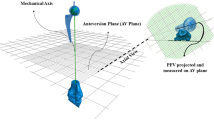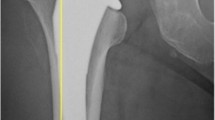Abstract
Centralising devices were introduced to ensure that the prosthesis is implanted in a neutral position and that a cement mantle of optimal thickness is achieved proximally and distally. A distal centralising device (DCD) is compared with a proximal midshaft centralising device (PCD) to test which one provides a more neutral prosthetic alignment. Thirty consecutive patients undergoing hemiarthroplasties for femoral neck fractures were studied prospectively. Patients were blindly randomised to receive either a femoral component with proximal midshaft centraliser or distal centraliser. Both components were implanted following the manufacturer’s protocol. Postoperative true anteroposterior and lateral radiographs were made to assess the stem position. There was no statistically significant difference between the two groups in zones 1, 2, 3, 4, 5, 6 and 7 in both anteroposterior and lateral radiographic measurements. DCP and PCD both have similar centralisation and cement mantle. Future studies should be done to evaluate their long-term effect.
Résumé
Objectif: un matériel permettant de bien centrer la prothèse a été utilisé de façon à avoir une prothèse en position neutre avec un manteau de ciment dont l’épaisseur doit être optimale aussi bien pour la partie proximale que distale. Le centralisateur DCD est comparé avec le matériel permettant de centraliser la prothèse PCD. Matériel et méthode: 30 patients consécutifs ont bénéficié d’une arthroplastie, après une fracture du col du fémur. L’étude a été prospective. Les patients ont bénéficié d’une randomisation en double aveugle de façon à recevoir soit un composant fémoral fixé par le centralisateur médio diaphysaire, soit un centralisateur distal. Les composants fémoraux ont été implantés selon les recommandations du fabriquant. Des radiographies face profil ont été réalisées de façon à évaluer la position de la queue de la prothèse. Résultats: il n’y a pas de différence significative entre les deux groupes dans les zones 1, 2, 3, 4, 5, 6 et 7 que se soit sur les radios de face ou de profil. En conclusion, DCP et PCD ont, toutes les deux, une fonction de centralisation et d’organisation du manteau de ciment. Des études ultérieures seront nécessaires pour évaluer les effets à long terme de cette technique.


Similar content being viewed by others
References
Anthony PP, Gie GA, Howie CR, Ling RSM (1990) Localised endosteal bone lysis in relation to the femoral components of cemented total hip arthroplasties. J Bone Joint Surg Br 72:971–979
Berger RA, Seel MJ, Wood K et al (1997) Effect of a centralizing device on cement mantle deficiencies and initial prosthetic alignment in total hip arthroplasty. J Arthroplasty 12:434–443
Charnley J (1979) Low friction arthroplasty of the hip. Theory and practice. Springer, New York, pp 66–90
Ebramzadeh E, Sarmiento A, McKellop HA et al (1994) The cement mantle in total hip arthroplasty. Analysis of long-term radiographic results. J Bone Joint Surg Am 76:77–87
Goldberg BA, Al-Habbal G, Noble PC et al (1998) Proximal and distal femoral centralizers in modern cemented hip arthroplasty. Clin Orthop Relat Res 349:163–173
Gruen TA, McNeice GM, Amstutz HC (1979) “Modes of failure” of cemented stem-type femoral components: a radiographic analysis of loosening. Clin Orthop Relat Res 141:17–27
Huddleston HD (1988) Femoral lysis after cemented hip arthroplasty. J Arthroplasty 3:285–297
Johnston RC, Fitzgerald RH Jr, Harris WH et al (1990) Clinical and radiographic evaluation of total hip replacement. A standard system of terminology for reporting results. J Bone Joint Surg Am 72:161–168
Kawate K, Ohmura T, Nakajima H et al (2001) Distal cement mantle thickness with a triangular distal centralizer inserted into the stem tip in cemented total hip arthroplasty. J Arthroplasty 16(8):998–1003
Levy R, Noble P, Scheller A Jr, Tullos H, Turner R (1988) The clinical reproducibility of precise asymmetric femoral cement mantle for total hip replacement. Orthop Trans 12:591
Pazzaglia UE (1990) Pathology of the bone-cement interface in loosening of total hip replacement. Arch Orthop Trauma Surg 109:83–88
Søballe K, Christensen F (1988) Calcar resorption after total hip arthroplasty. J Arthroplasty 3:103–107
Star MJ, Colwell CW, Kelman GJ et al (1994) Suboptimal (thin) distal cement mantle thickness as a contributory factor in total hip arthroplasty femoral component failure. A retrospective radiographic analysis favoring distal stem centralization. J Arthroplasty 9(2):143–149
Author information
Authors and Affiliations
Corresponding author
Rights and permissions
About this article
Cite this article
Aydin, N., Bezer, M., Akgulle, A.H. et al. Comparison of distal and proximal centralising devices in hip arthroplasty. International Orthopaedics (SICOT) 33, 945–948 (2009). https://doi.org/10.1007/s00264-008-0610-3
Received:
Revised:
Accepted:
Published:
Issue Date:
DOI: https://doi.org/10.1007/s00264-008-0610-3




